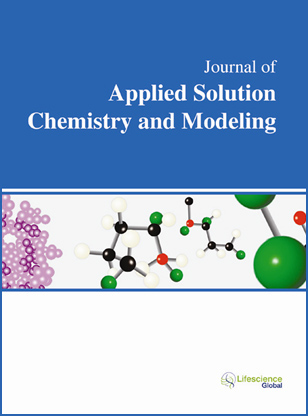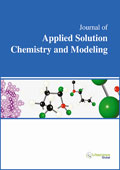JASCM
Journal of Applied Solution Chemistry and Modeling | Volume 4 Number 3
|
|
Structural Data, Linear and Nonlinear Optical Properties of Some Cyclic Phosphazenes: A Theoretical Investigation - Pages 132-142 Thermodynamic Modeling of Chiral Compounds Solubility Using Correlative and Predictive Models - Pages 143-151 Free Unsolvated Formaldehyde in Solutions: Influence of Temperature, Solvent Permittiity, and Total Formaldehyde Concentration - Pages 152-159
Excess Molar Enthalpies of Mixtures of Acetylene Tetrachloride with Dimethylsulfoxide, Acetone, Acetonitrile and N-Dibutyl Ether at 303.15 K - Pages 160-164 |
Journal of Applied Solution Chemistry and Modeling | Volume 4 Number 2
|
|
Benzothiazole-Based Bis-azo Cationic Fluorescent Dyes with Extended Conjugated Systems: Synthesis and Properties - Pages 83-94 Polymeric Versus Lipid Nanoparticles: Comparative Study of Nanoparticulate Systems as Indomethacin Carriers - Pages 95-109 Preferential Solvation of the Antioxidant Agent Daidzein in some Aqueous Co-Solvent Mixtures according to IKBI and QLQC Methods - Pages 110-118 Study of Molecular Interactions in Binary Mixtures of Diethyl Carbonate + Benzene Derivatives at Different Temperatures - Pages 119-127 The Influence of Solvent on Complex Formation of Crown Ether with Tetraphenylphosphonium Chloride - Pages 128-131 |
Abstract : Polymeric Versus Lipid Nanoparticles: Comparative Study of Nanoparticulate Systems as Indomethacin Carriers
|
|
Abstract: Encapsulation of nonsteroidal or non-steroidal anti-inflammatory drugs (NSAID) in nanocarrier systems aims to enhance bioavailability and to decrease toxicity of these drugs and thus improve the efficacy of treatments. With this aim two types of nanoparticles were prepared and compared: lipid nanoparticles, made of cetyl palmitate and Miglyol 812 which were uncoated or coated with chitosan; or polymeric nanoparticles, made of poly (DL-lactic-co-glycolic acid) (PLGA) for which different emulsion stabilizers were also tested (poly (vinyl alcohol) (PVA), and Pluronic F68). Nanoparticles were characterized for drug content and for particle size, charge and morphology. The lipid matrix was analyzed regarding its crystallinity by differential scanning calorimetry (DSC). The size of the nanoparticles was measured by dynamic light scattering (DLS) which indicated a unimodal particle size distribution in all systems. Nanoparticles’ stability was confirmed by their highly negative surface charge in the case of polymeric and uncoated lipid nanoparticles, as analyzed by zeta potential measurements using electrophoretic light scattering (ELS). Lipid chitosan coated nanoparticles have also shown to be stable presenting highly positive surface charge. Results have further demonstrated that indomethacin is highly encapsulated regardless the type of particles. Morphological analysis by scanning electron microscopy has shown that the nanoparticles were smooth and spherical. The results gathered within the current study point to the conclusion that the proposed formulations provide nanoparticles of satisfactory quality to encapsulate indomethacin, which might be used to improve bioavailability of other NSAID in the treatment of inflammation. Keywords: NSAID, PLGA nanoparticles, nanostructured lipid carriers (NLC), encapsulation efficiency, dynamic and electrophoretic light scattering (DLS and ELS), differential scanning calorimetry (DSC), electron scanning microscopy (SEM). Download Full Article |
Special Issues | Journal of Applied Solution Chemistry and Modeling
|
The following Special Issue(s) will be published in this journal. If you are interested to contribute to any of the listed Special Issue(s) below, please click on the email address given below. |
||||
| S. No | Guest Editors | Topic | Submit Manuscripts |
Description |
| 1 | Takashiro Akitsu | Organic/Inorganic Hybrid Materials for Energy and Environment | This email address is being protected from spambots. You need JavaScript enabled to view it. | View PDF Published |
| 2 | Tevfik Aysu | Conversion of Biomass into Biofuels with Supercritical Fluids | This email address is being protected from spambots. You need JavaScript enabled to view it. This email address is being protected from spambots. You need JavaScript enabled to view it. This email address is being protected from spambots. You need JavaScript enabled to view it. |
View PDF Published |
| 3 | Weifeng Shen | Application of Ionic Liquids: Thermodynamics and Properties | This email address is being protected from spambots. You need JavaScript enabled to view it. | View PDF Published |























